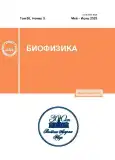Люминесцентная диагностика и количественная оценка малярийной инфекции методом латерального проточного иммуноанализа с применением квантовых точек из теллурида кадмия
- Авторы: Чаухан Х.1, Джаривала А.1, Кхерадж В.1
-
Учреждения:
- Национальный технологический институт Сардара Валлабхая
- Выпуск: Том 68, № 3 (2023)
- Страницы: 616-624
- Раздел: Статьи
- URL: https://journals.rcsi.science/0006-3029/article/view/144463
- DOI: https://doi.org/10.31857/S0006302923030237
- EDN: https://elibrary.ru/FTTHTS
- ID: 144463
Цитировать
Полный текст
Аннотация
Ключевые слова
Об авторах
Х. Чаухан
Национальный технологический институт Сардара ВаллабхаяГуджарат, Индия
А. Джаривала
Национальный технологический институт Сардара ВаллабхаяГуджарат, Индия
В. Кхерадж
Национальный технологический институт Сардара Валлабхая
Email: vk@phy.svnit.ac.in
Гуджарат, Индия
Список литературы
- X. Shi and Z. Wang, Rev. Med. Microbiol., 32 (3), 183 (2021).
- P. Liu, Y. Zhou, M. Guo, et al., Nanoscale, 10, 848 (2018).
- N. H. T. Tran, K. T. L. Trinh, J. H. Lee, et al., Small, 14, 1801385 (2018).
- R. Fan, W. Zhang, Y. Jin, et al., Microchim. Acta, 187, 1 (2020).
- Y. Liang, X. Huang, R. Yu, et al., Anal. Chim. Acta, 936, 195 (2016).
- G. Liu, J. Zhao, S. Wang, et al., Sensors and Actuators B: Chemical, 306, 127583 (2020).
- S. Wang, C. Zhang, and Y. Zhang, Biosensors and Biodetection, Ed. by A. Rasooly and K. E. Herold (Humana Press, 2009), vol. 504.
- Y. Jeong, Y. M. Kook, K. Lee, and W. G. Koh, Biosens. Bioelectron., 111, 102 (2018).
- S. M. Fothergill, C. Joyce, and F. Xie, Nanoscale, 10, 20914 (2018).
- G. A. Posthuma-Trumpie, J. Korf, and A. Van Amerongen, Anal. Bioanal. Chem., 393, 569 (2009).
- X. Gao, L. P. Xu, S. F. Zhou, et al., Am. J. Biomed. Sci., 6, 41 (2014).
- I. Y. Goryacheva, P. Lenain, and S. De Saeger, Trends Analyt. Chem., 46, 30 (2013).
- O. A. Aladesuyi and O. S. Oluwafemi, Nano-Structures & Nano-Objects, 24, 100568 (2020).
- Z. Li, P. Huang, J. Lin, et al., J. Nanosci. Nanotechnol., 10, 4859 (2010).
- Z. Wang, J.Ruan, and D. Cui, Nanoscale Res. Lett., 4, 593 (2009).
- D. Cui, B. Pan, H. Zhang, et al., Anal. Chem., 80, 7996 (2008).
- M. Sajid, A. N. Kawde and M. Daud, J. Saudi Chem. Soc., 19, 689 (2015).
- H. Yang, D. Li, R. He, et al., Nanoscale Res. Lett., 5, 875 (2010)
- J. Zhang, Y. Wei, S. Qiu, and Y. Xiong, Spectrochim. Acta, Part A: Mol. Biomol. Spectrosc., 247, 119107 (2021).
- U. Resch, H. Weller, and A. Henglein, Langmuir, 5, 1015 (1989).
- T. Lu, K. D. Zhu, C. Huang, et al., Analyst, 145, 76 (2020).
- World malaria report 2020: 20 years of global progress and challenges (World Health Organization, Geneva, 2020). Licence: CC BY-NC-SA 3.0 IGO, https://www.who.int/publications/i/item/9789240015791.
- D. Bell, C. Wongsrichanalai, and J. W. Barnwell, Nat. Rev. Microbiol., 4, 682 (2006)
- A. L. Rogach, L. Katsikas, A. Kornowski, et al., Ber Bunsen Phys Chem., 101, 1668-70 (1997).
- N. Liu and P. Yang, Luminescence, 29 (6), 566 (2014).
- S. Subramanian, S. Ganapathy, M. Rajaram, and A. Ayyaswamy, Materials Chemistry and Physics, 249, 123127 (2020).
- R. Carcione, F. Limosani, and F. Antolini, Crystals, 11 (3), 253 (2021).
- W. W. Yu, L. Qu, W. Guo, and X. Peng, Chem. Mater., 15, 2854 (2003).
- T. Kondratenko, O. Ovchinnikov, I. Grevtseva, et al., Materials, 13, 909 (2020).
- J. Tashkhourian, G. Absalan, M. Jafari, and S. Zare, Spectrochim. Acta A: Mol. Biomol. Spectrosc., 152, 119 (2016).
Дополнительные файлы










